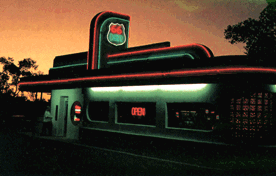
Albuquerque’s Nocturnal SpectacleA brief neon tour along old Route 66 . . . drawing with linear light in space. |
|
“The necessary physical characteristics of neon—including the rigidity and fragility of the materials and the tolerance of hostile attack of weather—produce some of the most unique drawing in art. I like my neon on, in sunshine, blanching all of the gross colors and providing a network of changing lines, shadows and hardware.” Robert Rauschenberg |
It has been said that "neon once meant progress, vitality and urban excitement, symbolizing America's energy." Neon has been a defining aspect of Albuquerque's personality and energy since the 1930s when neon signage, with its sassy vibrancy and clever versatility, was used all along Route 66 (now Central Avenue). Today, the urban nocturnal spectacle of glowing neon is still a vital presence on Central Avenue . . . One good ride along Old Route 66 from 98th on the west side to Tramway on the eastern edge of town, just about says it all in the way of neon for the Duke City! |
 The 66 Diner 1405 Central NE A staunch guardian of Route 66 folklore |
The centerpiece of a neon tour of Albuquerque is the historic Nob Hill district that extends along Central Avenue from Girard to Washington. The Nob Hill Gateways, a project of the City of Albuquerque Public Art Program Whimsy and fun are important elements in fulfilling neon's main job as a powerful visual promotional tool. All along Central Avenue between Dartmouth and Amherst there is continuous neon whimsy: slices of bread flipping out of the toaster at Fred's Bread and Bagel, concentric circularity of the green and pink Lobo Theater neon. In the next block, the In Crowd sign and the lit-up lips of Martha's Body Bueno seem to make passes at each other in the neon night. The purple neon elephant at Springtime for Children salutes the green and yellow O'Neill's Pub neon. Pick up Your Toys, Larry's Hats, Bow Wow Records, Aja, Double Rainbow . . . the list goes on and on. Some signs have, understandably, become beloved Albuquerque landmarks such as Scot's Dog Grooming's existential neon Scottie that never gets to the red-orange fire hydrant glimmering in the window. On the south side of Central Avenue at Carlisle, the Nob Hill Shopping Center is a veritable neon canvas. The La Montanita Co-Op sign and the window abstractions of the jovial store Beeps! all make the Center a neon delight. A bit further east, the Peoples Flower Shop sign uses four colors, a great font and accents of small neon flowers. Between Aliso and Morningside Absolutely Neon, Albuquerque's premier neon art studio shines—the creator of new neon and the renovator of old neon signs. |
On the marquee of the El Rey Theater, is a classic neon clock such as those made almost exclusively by the Glo-Dial Company of Lima, Ohio in the late 1930s. As the traveler leaves downtown heading west, the Grand Western Motel's neon "dining room" sign seems to evoke a log cabin or perhaps a caveman image . . . if the Flintstones had neon perhaps they would have used this type face! |
While our photo illustrations of neon are all from Route 66 sites, throughout Albuquerque are fine examples of "historic" neon signage and fresh new neon. The pink neon owlish outline of the Owl Cafe on Eubank, just north of I-40 is a beacon for those in search of good burgers and shakes. At Menaul and San Pedro a huge neon blue bowling pin with a blue bowling ball at its side proudly indicates the essential purpose of Fiesta Lanes on Menaul Boulevard. And among Albuquerque's favorite neon signs is the twenty foot tall monkey wrench that leaves no doubt about the business of Rupert's on Lomas west of Girard.
Thanks to Mark J. Gilboard of Albuquerque for being our intrepid Neon Scout. By Pamela Michaelis, founder of The Collector's Guide and former host of “Gallery News” radio show on KHFM 95.5 Originally appeared in |
|
LAST MODIFIED: September 22, 2008 |